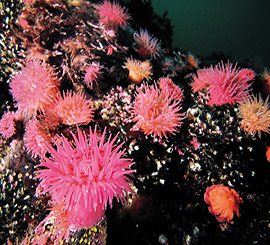Your knees shake. The wind howls past your ears. You shiver, despite the fact that you’re sweating. Adrenaline rushes through your veins as you hold your mask and blindly leap into the icy ocean below. You wouldn’t think we’re talking about pleasure-diving. Over the last few years, however, this image has become a reality for pleasure-diving in British Columbia. B.C.’s coastline has become a hot spot for divers and free-divers from around the world. People are choosing pebbles and cold over sun and sand for the underwater sights and sensations B.C. has to offer. And B.C. offers a lot. Local diving instructor Dave Orr and his business partner, Jodi Chang, run small dive tours off the West Coast and the islands. Orr has been diving in and around Vancouver for the past 10 years. His enthusiasm for the sport is contagious. After interviewing him for five minutes, I was ready to go wreck-diving at Porteau Cove.
Diving In B.C.
Fall is the best season for diving off the coast of B.C. In summer, the water can be murky. An overabundance of plankton reduces visibility to only a few feet, making an underwater experience fruitless. Around mid-September, the water temperature in B.C.drops. Over the season, temperatures can drop as low as four degrees Celsius. The colder temperature kills plankton and makes visibility crystal clear beneath the surface. Once winter hits, Orr and Chang start their busy season; their business benefits greatly from the large influx of tourists attracted by the snow of the ski slopes as well as the clean tides of coastal waters.
How To Keep Warm And Dry
Divers have a few choices when it comes to keeping warm underwater. Most professional divers wear neoprene drysuits over their clothes when cold-water diving. Drysuits use a thin layer of air between the diver’s skin and the material. The diver’s body heat warms air and insulates the suit. The main advantage of wearing a drysuit is noticeable when you’ve finished your dive; peel off the suit, and your body is completely dry. Orr claims, however, that he has come out soaked before, but only from exertion. There are a few disadvantages to wearing a drysuit. “It’s bulky and more cumbersome in the water than a wet suit,” Orr says. More irritating still, the extra air makes your body more buoyant, so extra weights are required to keep you submerged. Also, a change in pressure or angle of descent can make the suit press against you in uncomfortable, and sometimes painful, ways. Orr warned me about the danger of overheating while wearing a drysuit. He frequently stops along the bottom to cool down.
Directly off Stanley Park, wolf eels, swimming scallops, giant cod, and octopi swim among the flora of the seabed.
One urban legend about drysuits claims that if you don’t have your weight properly placed at your ankles on descent, air will rush to your legs and trap you upside down underwater with no way to right yourself. While he sees how this could happen, Orr has yet to witness it. Despite the low temperatures, it’s possible to dive in B.C.’s waters in a regular wet suit; some professional divers even prefer it. Orr recommends it for all first-time divers. He likes to see if they can hack it in a regular suit the first time out.
B.C.’s Waters Never Disappoint
His clients are never disappointed with what they see. Depending on the area, divers can expect to encounter an array of sea life. Directly off Stanley Park, wolf eels, swimming scallops, giant cod and octopi swim among the flora of the seabed. In the Campbell River area, seals, sea lions, and small sharks are common sights. One of the most desired animals to see in B.C. waters is the six-gilled shark, a relic from prehistoric times. This bottom-feeder is not dangerous to divers and is also a common sight locally. Whales can be seen frequently near Campbell River, and even experienced divers know enough to get out of the water when a whale comes near. Killer whales especially have been known to become aggressive toward divers. This isn’t surprising, considering that a diver is approximately the same size and shape as the seals that whales feed on.



Octopi (top), sea anemones (centre), and wolf eels (bottom) are common sights off the BC coast. Divers can also expect to see ling cod, starfish, harbour seals, and sea lions.
Free-Diving
For those looking for more of a thrill than just observing under the water, imagine diving without an air tank. Free-diving is like an intense form of snorkeling. It combines pleasure-diving and depth-sounding, and is as popular as open-water diving in B.C. When a diver breathes from a tank, the air is pressurized and becomes more so on descent. This means that if you have a breath at the bottom of the sea, that same breath is much larger on the surface. Divers have to come up very slowly to avoid damage to their lungs from air expansion. Free-divers do not have to do this because all their breaths are on the surface. Free-diving is taken very seriously as a sport in B.C. with biannual and annual competitions ranging from static apnea to depth-reaching. Divers compete without fins or lines to follow on the way down. However, weights and masks are permitted in the minor and international leagues. It seems that the days are gone when being thrown into the ocean with a pair of concrete shoes was a bad thing. The international free-diving competition was held in France in 2000. Competitors came from over 20 different countries. Canada placed second overall in men and women’s finals. In August 2001, Eric Fattah dove an amazing 83 feet in 2 minutes, 59 seconds, to set a free-diving world record at Ansell Point in Vancouver.
Why Do People Come To Dive In B.C.?
Vancouver’s dive community is a well-kept secret. When asked why his business had suddenly taken off, Orr responded “Vancouver has the best cold-water diving in the world.” He lists several sights within a two-hour radius. The area has one of the highest concentrations of wreck dives this side of Nicaragua. There are wrecks all along the coast: at Whytecliffe Park, Porteau Cove and Ansell Point. These wrecks are some of the greatest sights in B.C. yet few people know they exist. Most of the wrecks are suitable for first-time divers, especially if a trained wreck-diver leads the tour. B.C. even offers a selection of lakes to be dived in the immediate area if the ocean offers too much of a challenge to first-timers. Alouette and Sasamat are two of the more popular lakes frequented by divers in the Lower Mainland. One of the more spectacular times of the year to lake-dive is during the salmon runs in early September, when the water is full of bright-red spawning salmon. There are subtle differences between ocean-diving and lake-diving. First, lakes, unless they are glacier fed, are warmer than the ocean. As well, mass is less buoyant in fresh water, making it easier to dive. Finally, lake life is just as diverse as ocean life. Besides huge red salmon, giant bullheads, giant cod and, occasionally, six-gilled sharks are known to live in fresh water. B.C. cold-water diving has yet to reach its full potential. Sincere efforts should be made to get B.C. diving on the world map. The diving industry is more developed than it was 10 years ago, but it struggles in comparison to Australia and tropical vacation destinations. After all, tourists can’t enjoy what they don’t know is there. Offering scenic ocean dives, adrenaline-packed free-diving, and fresh-water exploration, British Columbia gives those seeking underwater adventure more than enough reasons to take the plunge.











